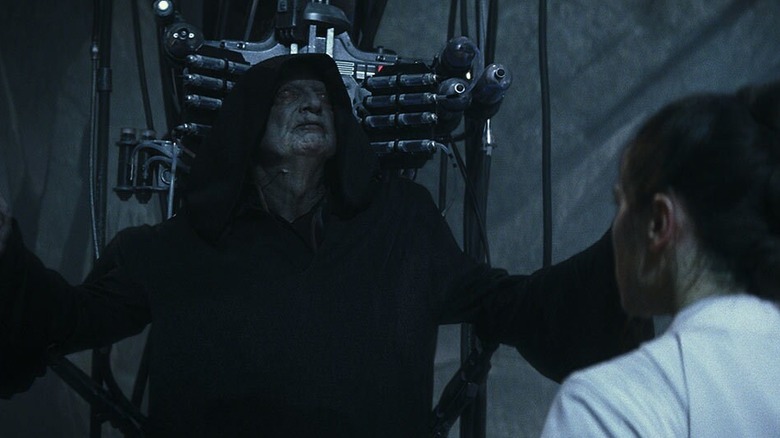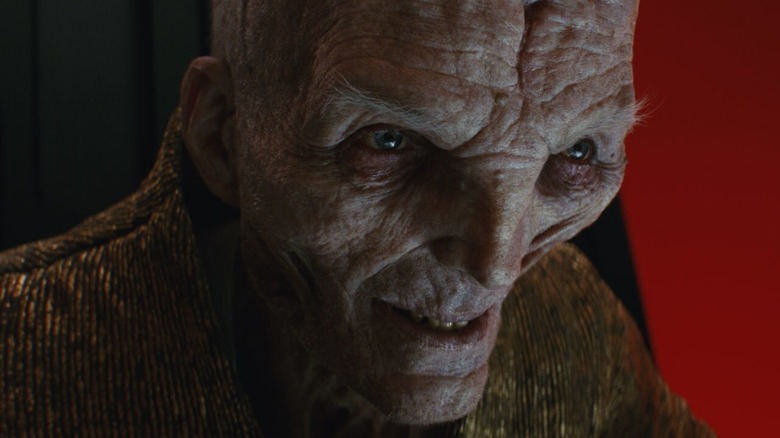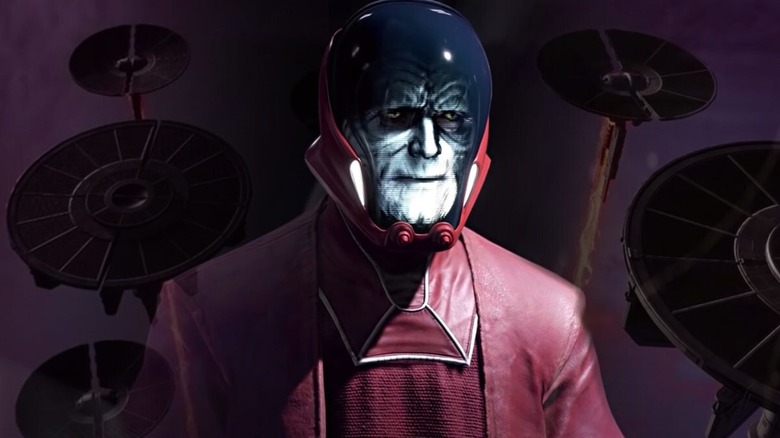Star Wars: How Did Palpatine Survive After Return Of The Jedi?
We may receive a commission on purchases made from links.
Call him Palpatine. Call him Darth Sidious. Call him the Emperor. At the end of the day, in the "Star Wars" galaxy, it all ultimately means the same thing. These many names lead us to the same, evil presence, played most famously by Ian McDiarmid in "Star Wars: Episode VI — Return of the Jedi" and the prequel trilogy. While he's not the only actor to bring Palpatine to life over the years, he's probably the one most associated with the Sith mastermind who brought down the Old Republic.
Palpatine is such a villainous mastermind that he was even able to cheat death. Darth Vader ended up turning on his former master at the end of "Return of the Jedi," tossing him into the depths of the second Death Star before it was destroyed by the Rebels' fleet. The Emperor was dead and the galaxy was free of the Empire's reign. Sort of. The remnants of the Empire remained as the New Republic was formed, but the important thing was that the leader of the organization was (seemingly) dead.
However, as we would learn in 2019's "Star Wars: Episode IX — The Rise of Skywalker," Palpatine returned from the dead somehow to try and reclaim the galaxy. He was ultimately thwarted by Rey (Daisy Ridley), who was revealed to be his granddaughter. However, even though this was a massive plot point in the film, Palpatine's return wasn't explained all that well.
So, how exactly did Palpatine survive? There is an answer in the official "Star Wars" canon, but it's a little complicated. Even so, we're going to get to the bottom of it. Let's dive in.
Palpatine's survival wasn't explained in the movies
Before diving into how Palpatine survived his evident demise, we should take a moment to discuss what "The Rise of Skywalker" has to offer on the subject. In short? Very little is explained by the movie itself. Even Poe Dameron (Oscar Isaac) simply and somewhat infamously says, "Somehow, Palpatine returned," skirting any real details. We also get some vague implication that some sort of dark side science was used when Kylo Ren (Adam Driver) visits Exegol in the beginning of the film.
Beyond that, it's all left pretty vague. In short, viewers who were confused by the Sith Lord's return didn't miss anything, it's just that J.J. Abrams' movie doesn't provide much in the way of concrete answers. The "Star Wars" movies have often used other forms of media — be they books or the animated shows — to fill in gaps in their lore. In this case, Palpatine's speech mentioned at the start of "Rise of Skywalker" was actually part of a special event in the video game "Fortnite." It wasn't included in the film itself, however, which is certainly an interesting choice. In the years since its release, other parts of the franchise have helped fill in the film's gaps, but only hardcore fans would likely have put any of those pieces together.
More casual viewers, on the other hand, were left with big questions after watching the finale to the Skywalker Saga. Right or wrong, this is how Abrams and Lucasfilm opted to handle the big decision to bring back one of the property's most notorious villains. Now, let's take a look at the answers that have been provided outside of the movies.
Palpatine planned for his potential death long before it happened
Even before we knew that Palpatine would make his grand return to the "Star Wars" galaxy in "Episode IX" to help close out Disney's sequel trilogy, it was clear that the Sith Lord was interested in cheating death. Rather famously, Palpatine tells Anakin Skywalker (Hayden Christensen) about the tragedy of Darth Plagueis the Wise during "Star Wars: Episode III — Revenge of the Sith." It was later cemented in canon that Palpatine was Plagueis' apprentice, who eventually killed his master.
The Plagueis connection is important because the appeal of this powerful Force user was that he had apparently found ways to cheat death, which appealed to Anakin because he wanted to save his wife Padme (Natalie Portman) from her grim fate. This was used as leverage by Palpatine to corrupt Anakin and turn him into Darth Vader. As it relates to what we're discussing now, it's evident that Palpatine, even before "Star Wars" fans knew him by that name, had been researching ways to live on eternally in some fashion.
As we'll dive into further here shortly, Palpatine ensured that his legacy would live on in some way, and that the Empire could still thrive even after his passing. He was obsessed with ensuring that he could retain power, even in death. Even though "Rise of Skywalker" didn't do a good job of explaining the logistics, "Star Wars" has made it clear that this is a power hungry Sith who sought to keep his power indefinitely.
Palpatine survived using advanced cloning techniques
Cloning has been a thing in the "Star Wars" galaxy for a long, long time. Before Disney purchased Lucasfilm in 2012 and abandoned what we used to know as the Expanded Universe (which has since been renamed Star Wars Legends), cloning came into play in a big way in several storylines in the EU books. It's become part of the new canon as well, with cloning being a central part of Palpatine's plan to return from the dead.
Ultimately, the Sith Lord used the planet Exegol as a place to research ways to cheat death and lay the groundwork for what was dubbed the Final Order, including a massive fleet of Star Destroyers capable of destroying planets like the Death Star. Additionally, he researched cloning techniques there alongside his cult-like loyalists, known as the Sith Eternal. In a 2021 article on StarWars.com, the details of this cloning operation were laid out in detail:
"When Palpatine was killed on the second Death Star, his consciousness transferred to a clone of his own body on Exegol but the body was too weak to contain him. This led to Palpatine creating more clones and strand-casts of himself in the hopes that one would offer a more suitable vessel for him to inhabit. All of this effort ultimately culminated in Rey, the daughter of one of Palpatine's strand-casts. She was the perfect vessel — but her father and mother did everything they could to hide her from her sinister grandfather."
Some of this top secret cloning has been hinted at in other "Star Wars" media. It is believed that the mysterious "Project Necromancer" that was mentioned in "The Mandalorian" season 3 (as well as the final season of "The Bad Batch") might be connected to Palpatine and his operation on Exegol.
What is Operation: Cinder in the Star Wars galaxy?
Though not directly related to Palpatine's eventual resurrection, Operation: Cinder is another crucial part of the Emperor's plan to ensure that his legacy lived on. It also serves as an attempt to make it more difficult for a new government to form in place of the Empire.
Again, this isn't something that was explored in the Skywalker Saga. Rather, it was laid out in various other projects, including author Chuck Wendig's "Aftermath" trilogy, which helps explain what happened between "Return of the Jedi" and "Star Wars: Episode VII — Force Awakens." The operation was also included in the comic "Shattered Empire," as well as the video game "Battlefront II," which allowed players to experience it first hand. It was even mentioned by name in "The Mandalorian."
Operation: Cinder, in other words, is a pretty big deal, even though, again, it's not mentioned by name in the central "Star Wars" movies. But what is it, precisely? A 2021 article on StarWars.com broke down the specifics of the project. Basically, it was a major part of Emperor Palpatine's evil contingency plan, which he laid the groundwork for years before his unexpected demise at the hands of his former apprentice. Per the website:
"In the event of the Emperor's death, a series of red-robed messenger droids were to go out to designated members of the Empire and deliver his final orders. Those orders? To burn away the ideals of resistance, rebellion, and defiance through attacks that would scour a planet such as Palpatine's own homeworld of Naboo. The logistics of Operation: Cinder involved using climate disruption arrays to alter the weather around the planet in order to create catastrophic storms that would wreak havoc on key inhabited worlds. These attacks were supplemented by the Imperial Fleet participating in orbital bombardments."
The Empire's Admiral Garrick Versio believed these attacks were "a calculated campaign of fear to reclaim control." The idea being that, even with the Emperor gone and the second Death Star destroyed, if the Empire demonstrated that it still had enough power, people would quit on the New Republic.
In the end, the whole exercise was devastating, wiping out entire planets. However, it also firmed up allegiances within the New Republic, with a great many Imperials defecting. Imperials defecting is nothing new, with rebel hero Wedge Antilles famously leaving the Empire to join the Rebellion. In any event, Palpatine's presence was needed a bit more directly.
Palpatine was still pulling the strings behind the scenes
Even though Palpatine wasn't alive, per se, for a number of years following the events of "Return of the Jedi," he lived on in a big way as he was largely pulling the strings from behind the scenes. Snoke, for example, was introduced as a major antagonist in "The Force Awakens" before being killed in "Last Jedi" and later revealed as one of Palpatine's duplicates. Be it Snoke and the First Order or Palpatine and the Empire, the result was largely the same. That was by design.
It was through Snoke's corruption of Kylo Ren that Palpatine was ultimately led back to Rey, who was the perfect vessel for him to make a more meaningful return. As we saw in "Rise of Skywalker," the body he had conjured wasn't exactly fit for the evil ruler of the galaxy. The point is, all of this meddling that took place off screen and/or in other media brought Kylo to Palpatine and, in the end, Rey to his doorstep as well. Whether or not anyone in the galaxy was aware that he was lurking in the background, his bidding was still being done through some expert puppetry as only Palpatine could execute.
The main thing is, even if the particulars of Palpatine's resurrection are messy, "Star Wars" has done a good job of making it clear that we are dealing with a mastermind. Not only that, but also a mastermind capable of playing two sides of a war, and one who was on the cutting edge of cheating death decades before he managed to actually pull it off. Maybe the details are muddy, but if anyone could resurrect themselves in the galaxy, it's Palpatine.
You can buy all of the "Star Wars" movies on 4K, Blu-ray, or DVD from Amazon.





